Basal Ganglia ( lecture 6)
1/88
There's no tags or description
Looks like no tags are added yet.
Name | Mastery | Learn | Test | Matching | Spaced |
|---|
No study sessions yet.
89 Terms
what are the two functions of the basal ganglia
motor control and motor learning
the basal ganglia function to perform what type of actions
selection and initiation/ executing actions
the BG consist of several interconnected ____
nuclei
what are the 4 main nuclei of the basal ganglia?
striatum, globus pallidus, subthalamic nucleus, and substantial nigra
Which structures make up the striatum?
caudate nucleus, putamen, and nucleus accumbens - ventral striatum
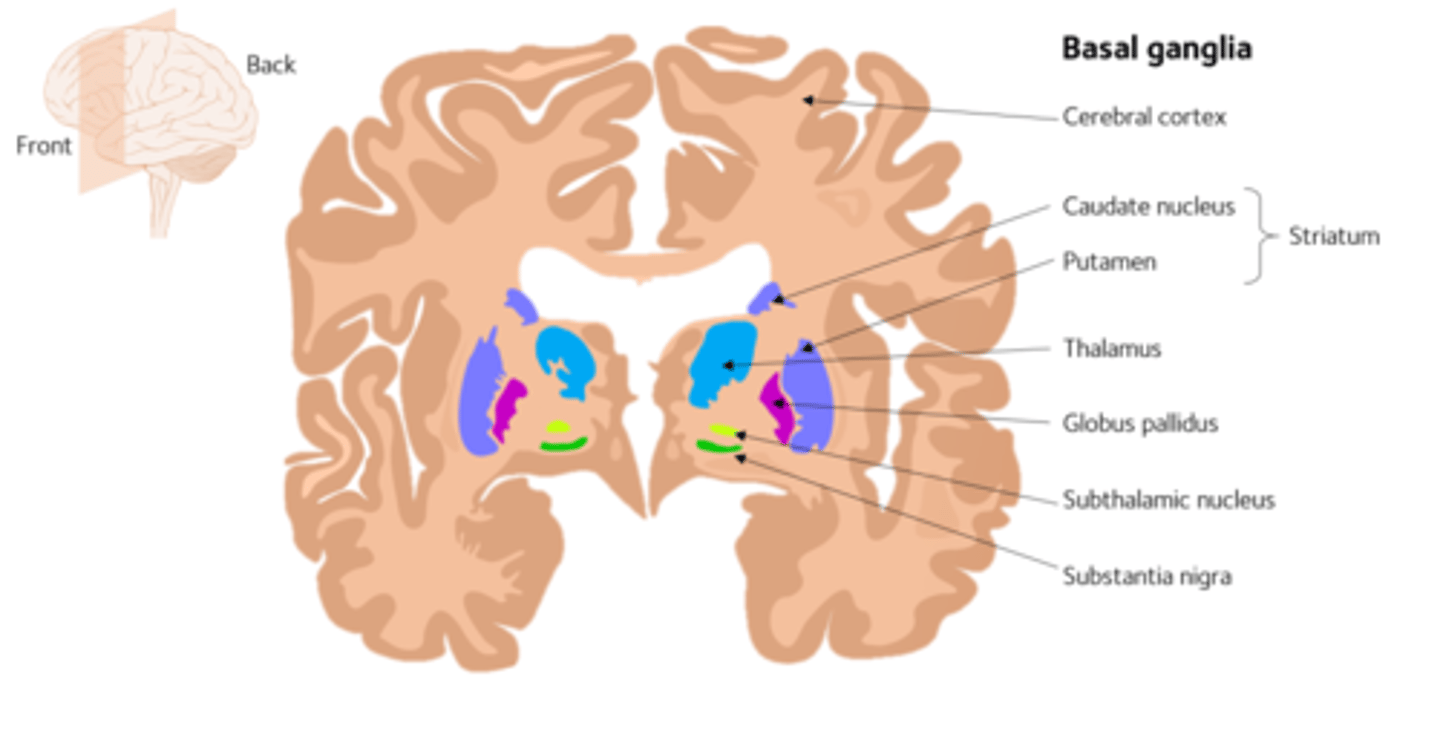
what structures make up the globus pallidus?
external and internal segment
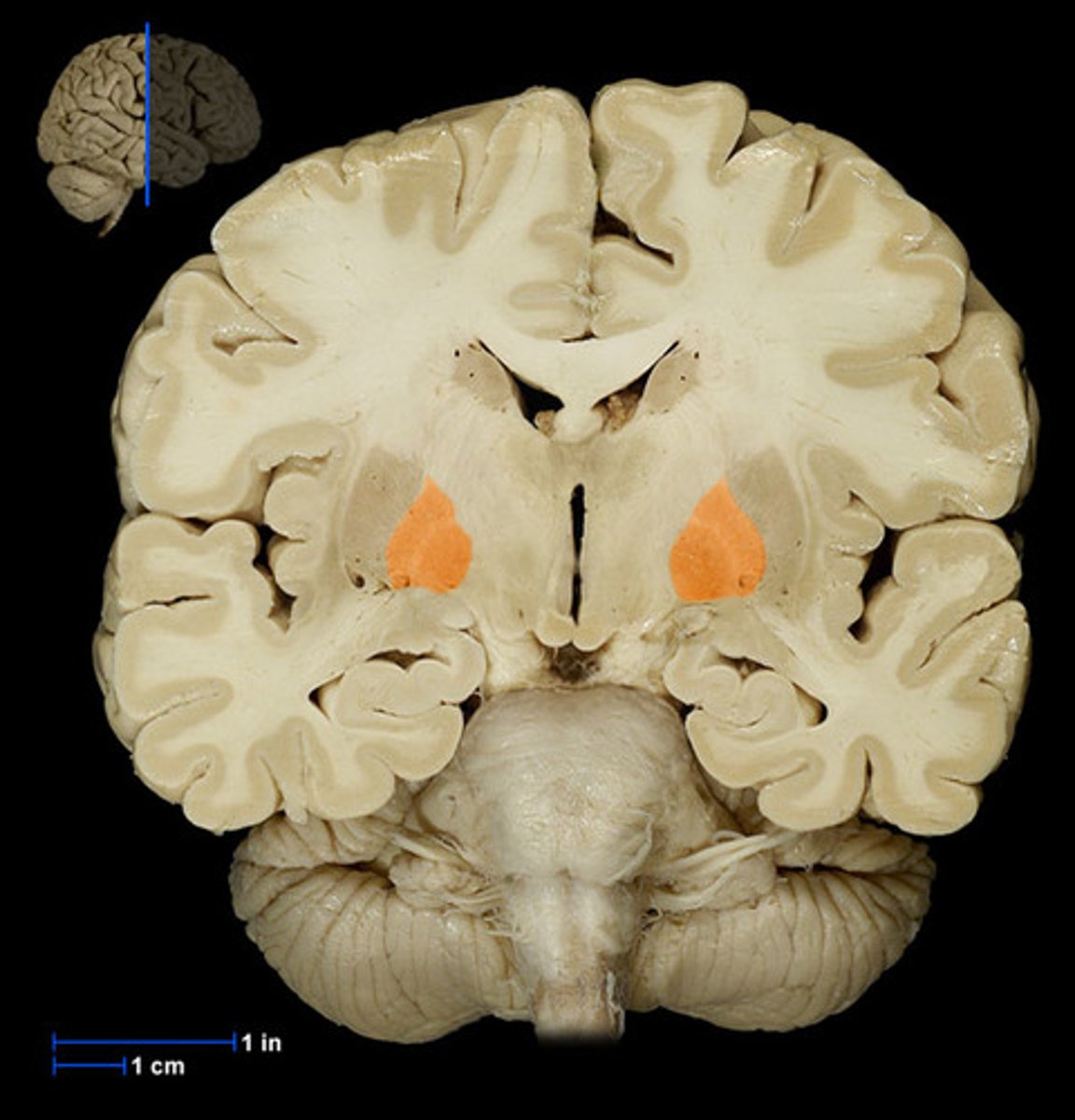
what structures make up the substantia nigra?
pars compacta and pars reticulata
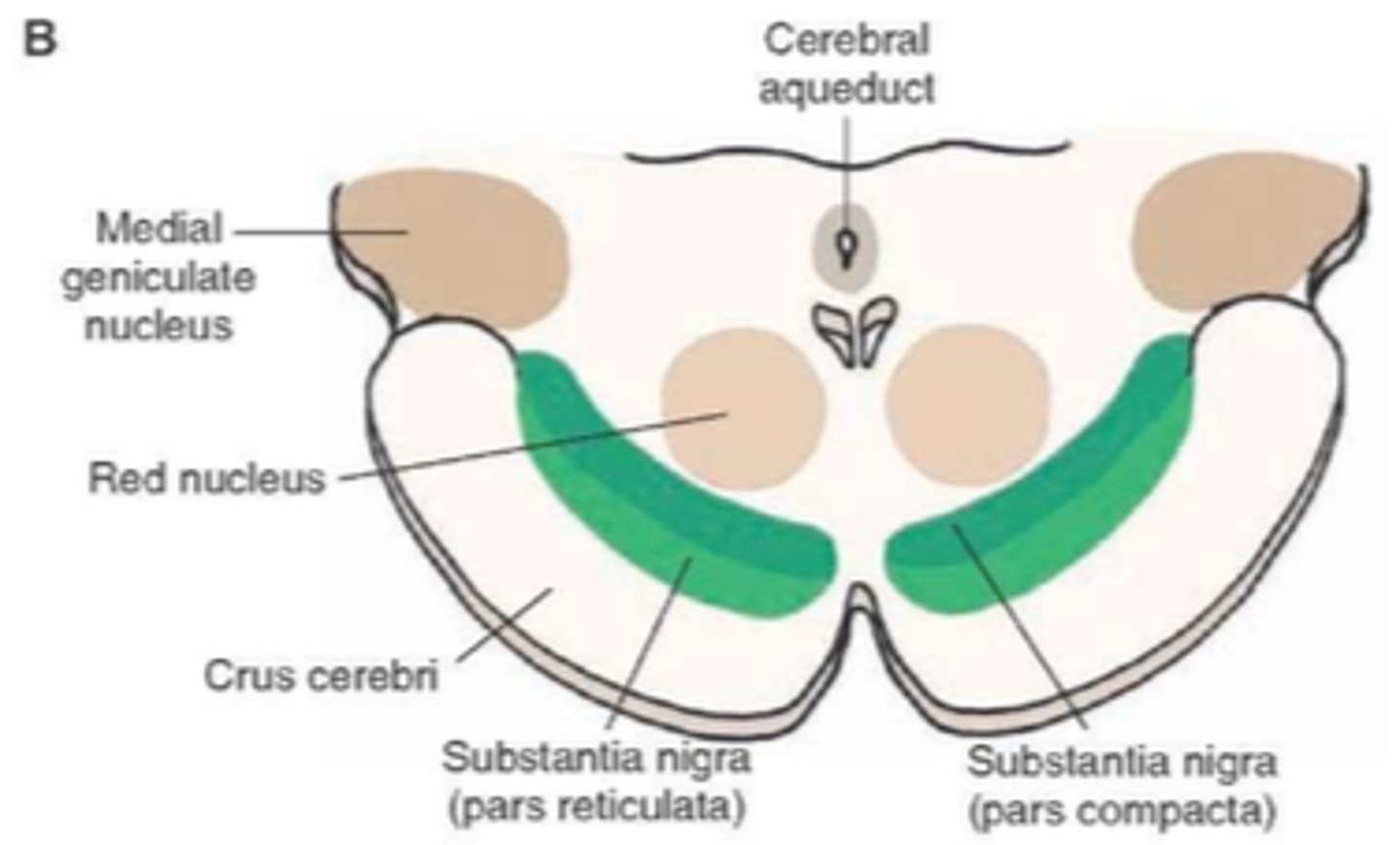
out of all the basal ganglia nuclei, what is the main input nucleus?
striatum
what are the two output nuclei for the basal ganglia
globus pallidus internal segment and substantia nigra
where do the output nuclei project to
the thalamus or the brainstem
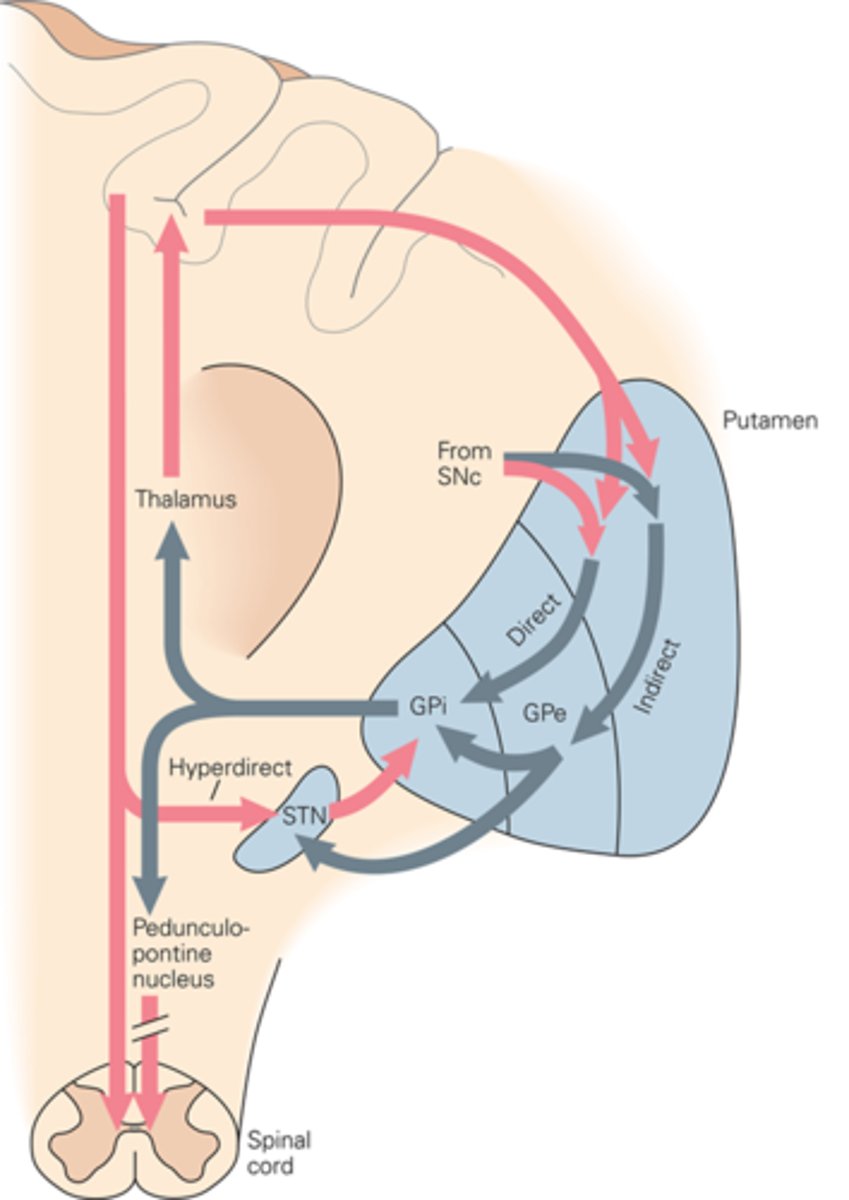
where is the substantia nigra located?
midbrain
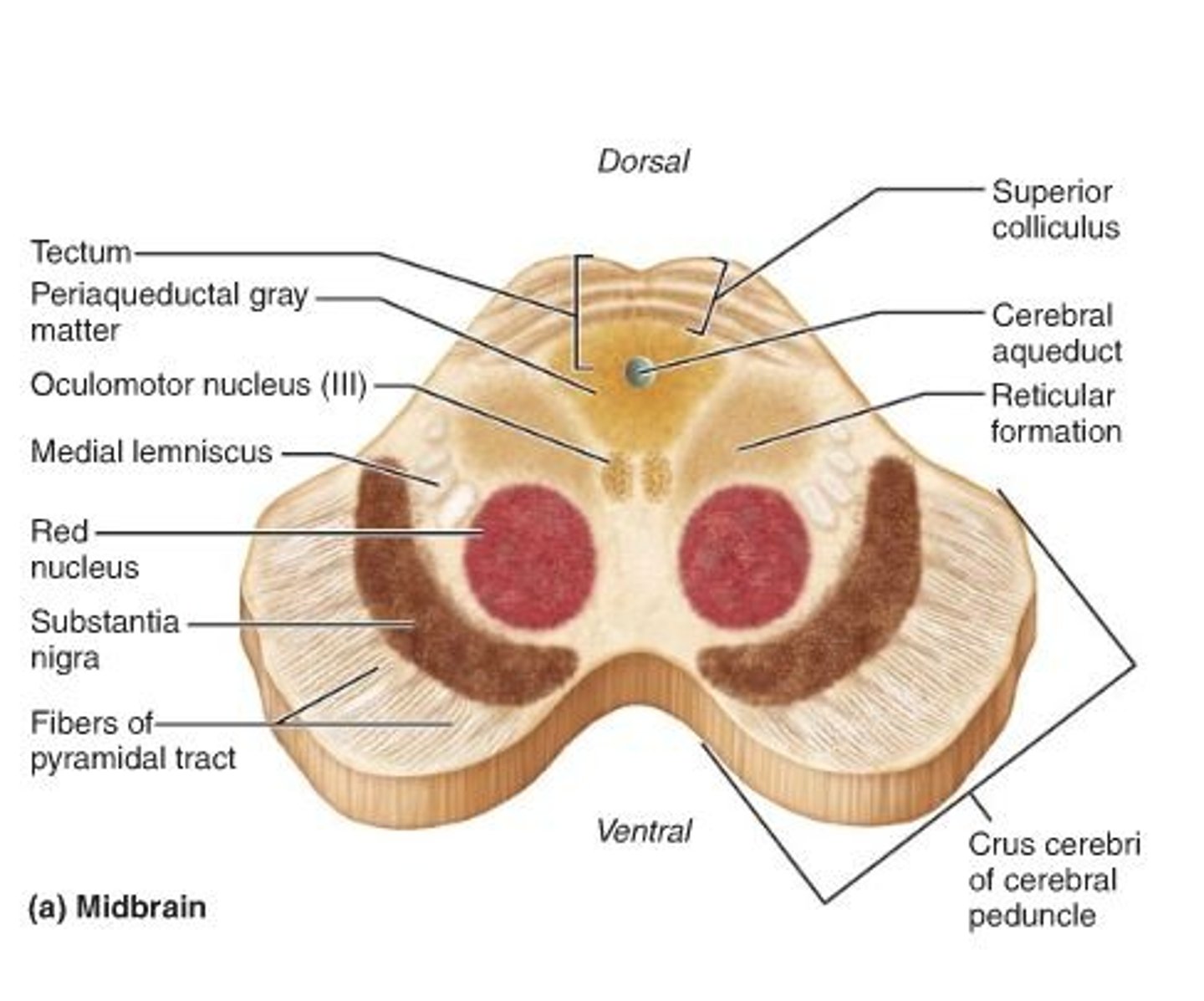
what structures make up the basal ganglia intrinsic layer?
globus pallidus external segment, subthalamic nucleus, substantia nigra pars compacta
what structures provide input to the stiatum?
cerebral cortex and the substantia nigra pars compacta
a brain circuit that connects the cortex to the striatum
corticostriatal pathways
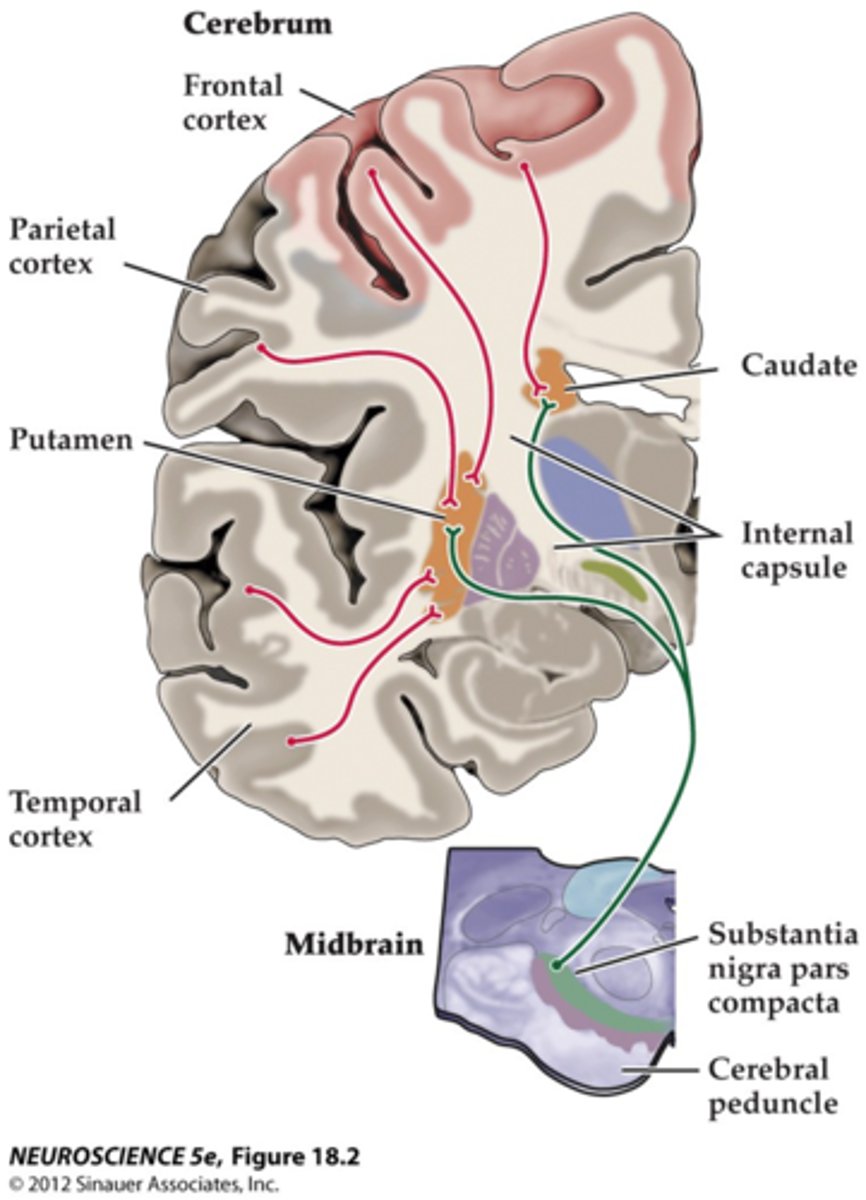
a brain circuit that connects the substantia nigra pars compacta to the striatum
nigrostriatal pathways
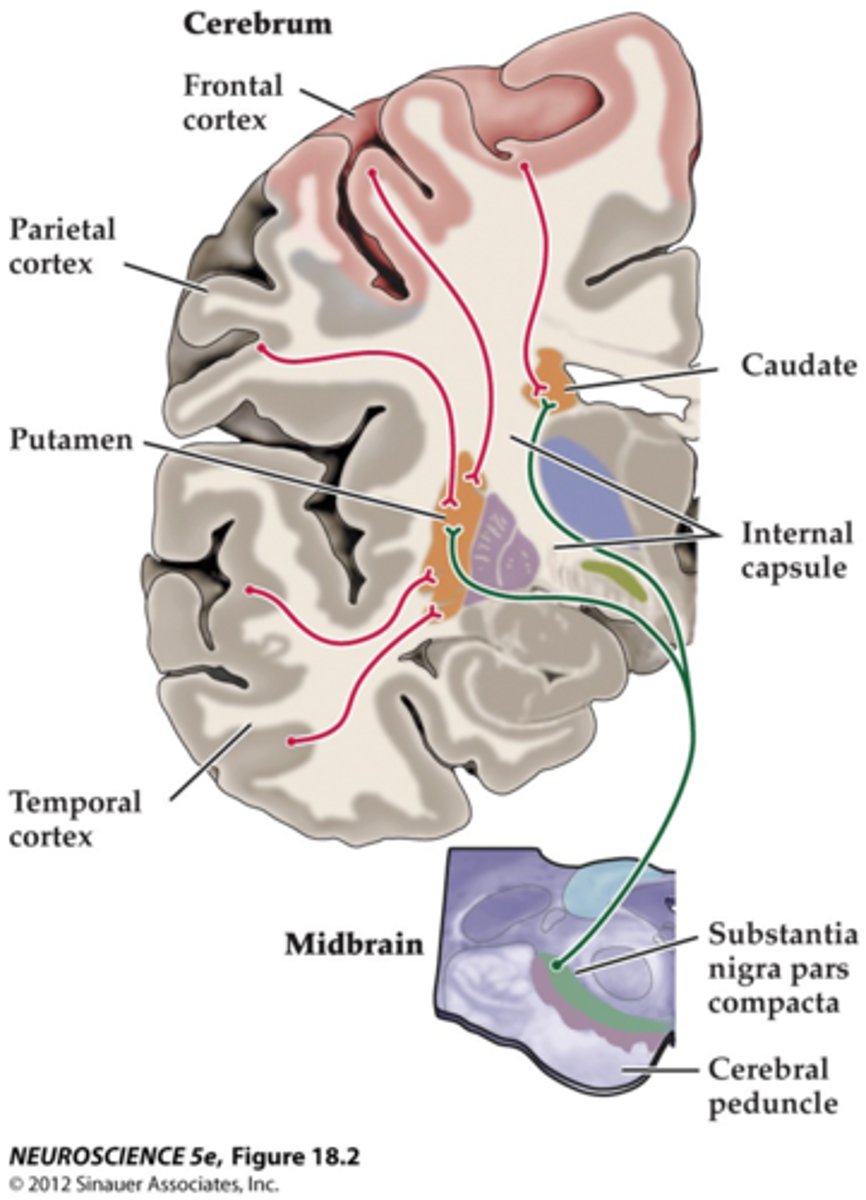
what neurotransmitter does the corticostriatal pathway use? is this inhibitory or excitatory?
glutamate ( excitatory)
what neurotransmitter does the nigrostriatal pathway utilize? Is this inhibatory or excitatory?
dopamine ( either excitatory or inhibitory)
list the steps of the direct pathway ( don't include neurotransmitters)
1. cortex or substantia nigra pars compacta send an excitatory signal to the striatum (caudate or putamen)
2. the caudate/ putamen sends and inhibitory signal to the globus pallidus internal segment
3. the globus pallidus internal segment sends an inhibitory signal to either the thalamus or the brainstem
list the steps of the indirect pathway ( don't include neurotransmitters)
1. cortex or substantia nigra pars compacta send an excitatory signal to the striatum (caudate or putamen)
2. the striatum ( putamen or caudate) send an inhibitory signal to the globus pallidus external segment
3. the globus pallidus external segment sends an inhibitory signal to the subthalamic nucleus
4. the subthalamic nucleus sends an excitatory signal to the globus pallidus internal segment
5. the globus pallidus internal segment sends an inhibitory signal to the thalamus or brainstem
what are the two most common neurotransmitters that can be utilized by the output systems?
GABA and glutamate
what neurotransmitter does the subthalamic nucleus release to excite the globus pallidus internal segment
Glutamate
what neurotransmitter does the putamen/caudate release to inhibit the GBi or GBe segments?
GABA
what neurotransmitter does the GBe use to inhibit the Subthalamic nucleus?
GABA
what is the main inhibitory neurons projecting from the striatum (caudate and putamen) ?
medium spiny neurons
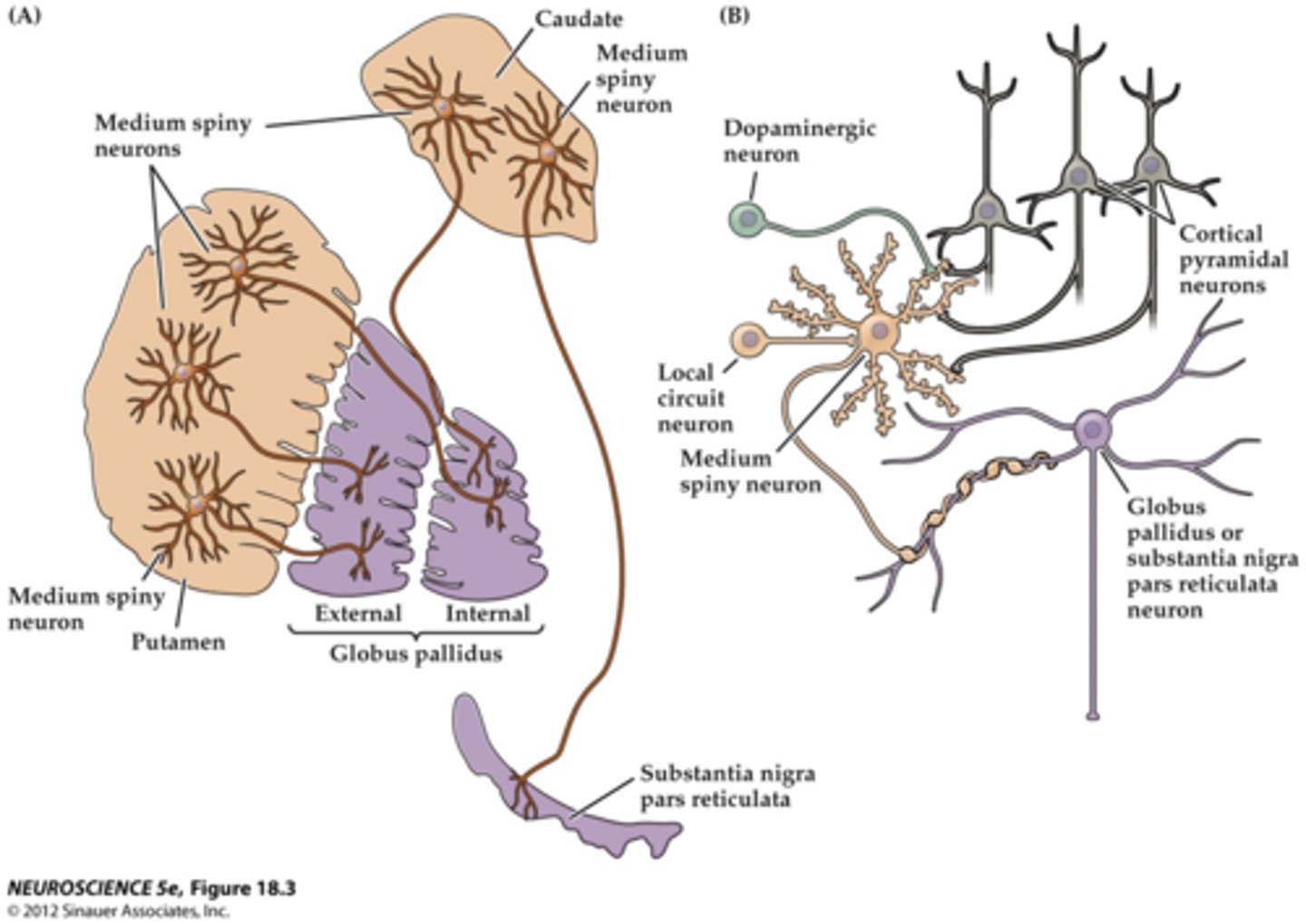
where do the medium spiny neurons project to?
globus pallidus internal and external segment
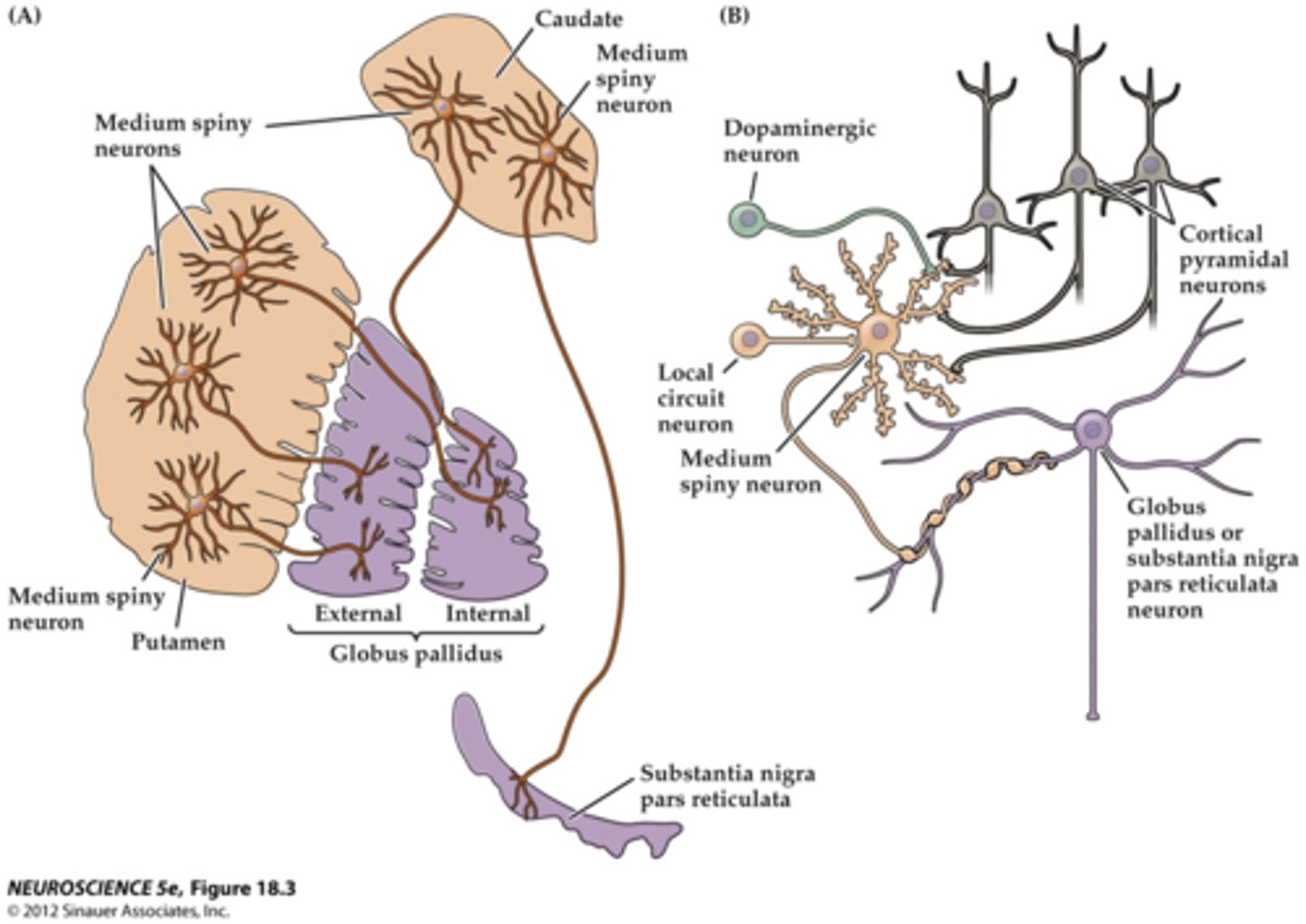
input to the medium spiny neurons from the cortex and the substanstia nigra pars compacta is called what type of input?
extrinsic input
what does disinhibition mean?
removing the inhibition
list the order of the disinhibitory circuit
striatum (inhibitory) - GP- ( inhibitory) thalamus - (excitatory) M1
what kind of output does the globus pallidus prove the thalamus at rest
tonic inhibition output to the thalamus
At rest, how does the disinhibitory circuit work to inhibit movement?
at rest the cortex provides no stimulus to inhibit the striatum, striatum provides no stimulus to inhibit the globus pallidus, the Globus pallidus will have tonic inhibition to inhibit the thalamus, which inhibits the primary motor cortex
during movement, how does the disinhibitory circuit work to excite M1 and cause movement?
cortex provides excitatory stimulus to striatum, striatum inhibits the globus pallidus, which means it cannot inhibit the thalamus, the thalamus excites M1 and produces movement
what are the 4 major basal ganglia circuits?
motor, oculomotor, executive/associate, emotion, motivation
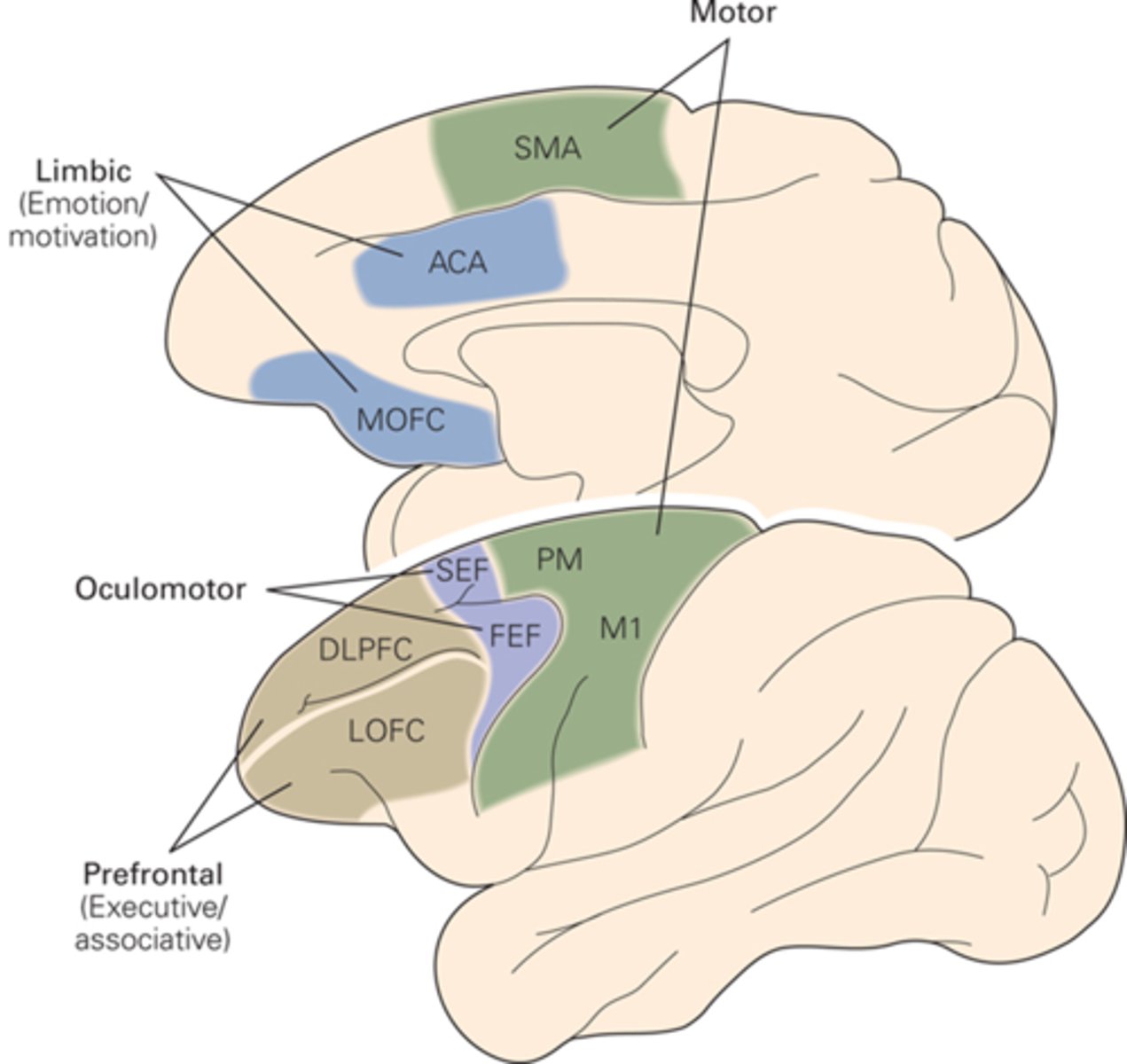
what areas does the motor circuit of the basal ganglia receive input from?
M1, SMA, PMC and CMA
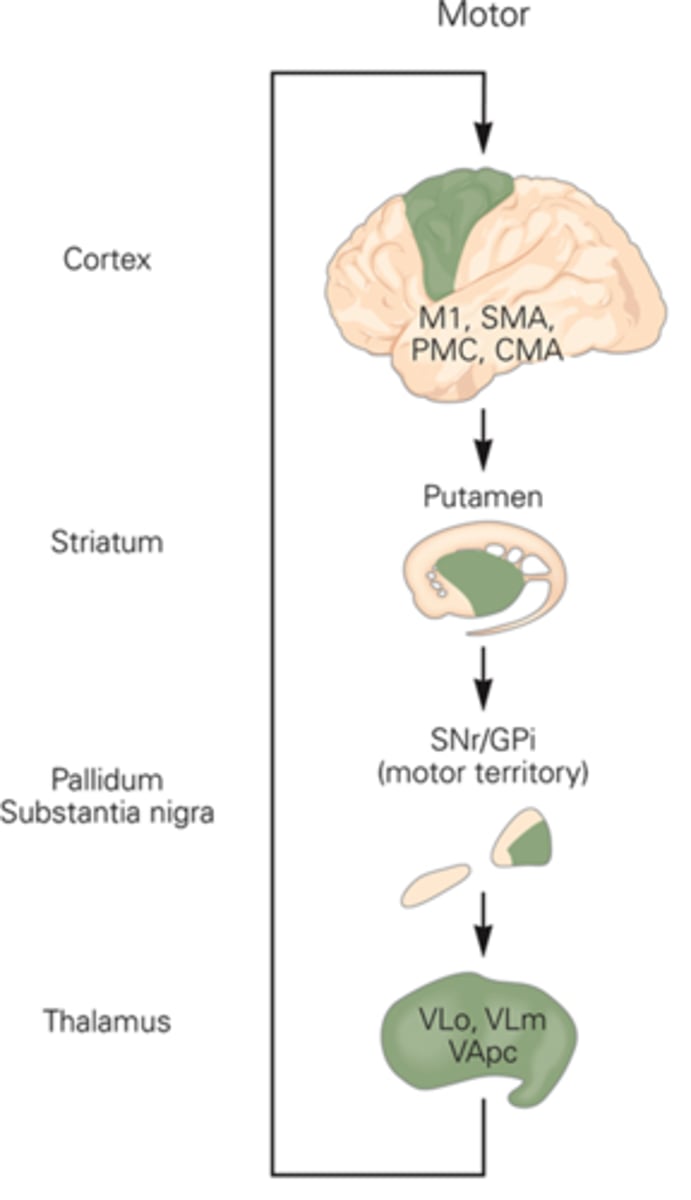
what is the difference between the input that the globus pallidus internal segment provides and the cerebellum provide the thalamus at rest?
the globus pallidus provides the thalamus with tonic inhibition, the cerebellum provides the thalamus with tonic excitatory
what is the function of the motor circuit in the motor control?
voluntary muscle activity, via the motor thalamus and then to the cerebral cortex
what is the importance behind the cerebellum providing tonic excitatory inputs to the thalamus and the GPi prviding tonic inhibitory inputs to the thalamus simultaneously?
cerebellum helps with muscle tone while globus pallidus inhibits unnecessary movements
what structure in the striatum is associated with the motor circuit?
putamen
list the steps of the motor circuit ( simple)
M1- putamen- GPi- thalamus ( VL)
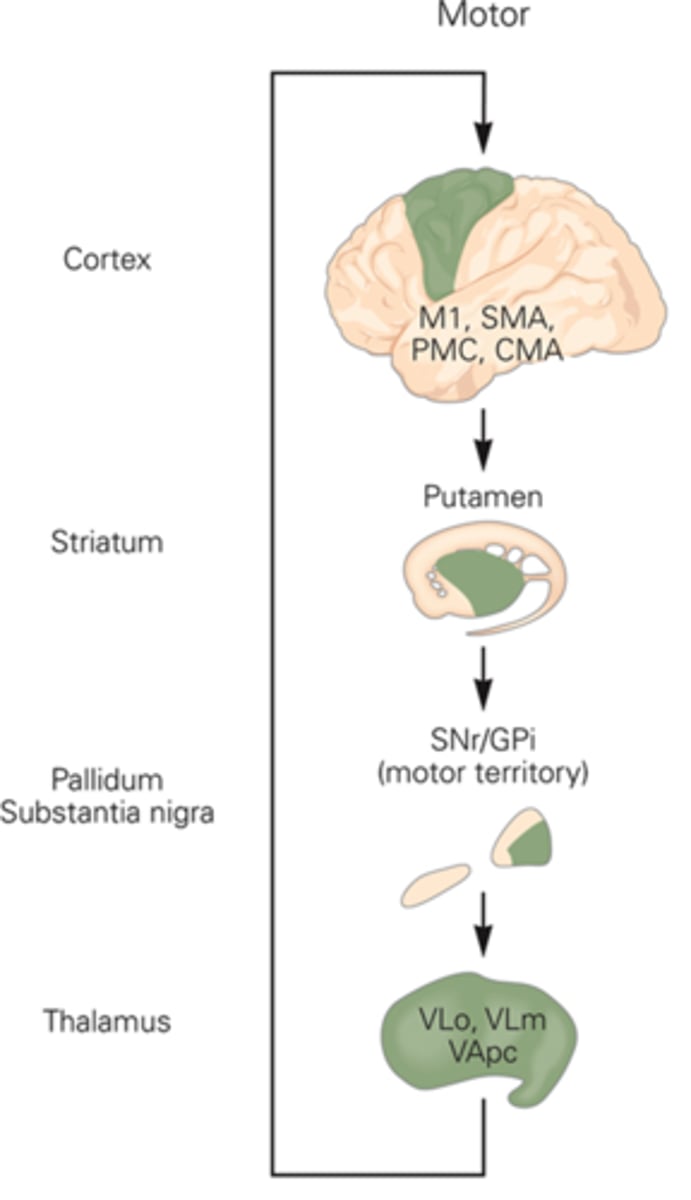
the ventrolateral nucleus of the thalamus is also known as what
the motor thalamus
what is the origin of the oculomotor circuit
frontal eye field and supplementary eye field
what is the function of the oculomotor circuit
helps in decisions about eye movements and spatial awareness
where does the executive/associate (prefrontal) circuit origniate?
dorsolateral prefrontal cortex and lateral orbitofrontal cortex
input to the executive/associate circuit that is related to executive functions
dorsolateral prefrontal cortex DLPFC
input to the executive/ associate circuit that is related to empathic and socially appropriate responses and behavior
lateral orbitofrontal cortex LOFC
where does the limbic circuit originate
anterior cingulate area and medial orbitofrontal cortex
what are the functions of the limbic circuit
limbic, cognitive, and motor systems, identifies value of stimuli , involved in reward guided behaviors, and concerned with seeking pleasure and novelty
the major outputs of the basal go where?
cortex
what are the three non-cortical structures that receive outputs from the basal ganglia
pedunculopontine nuclei, locomotor centers in the midbrain reticular formation, and superior colliculus
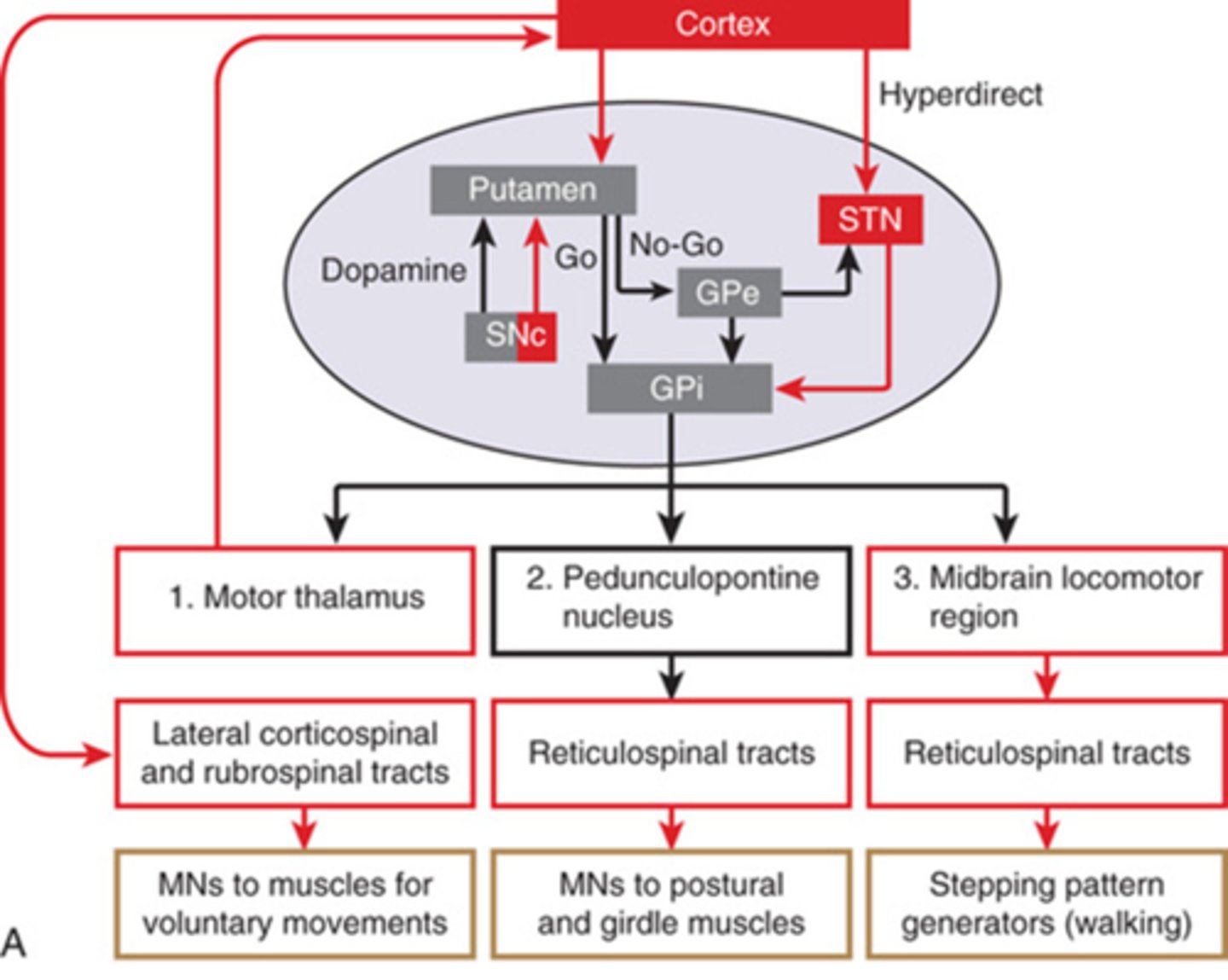
what type of signal does the GPi have on the pedunculopontine N
tonic inhibition

what tract does the pedunculopontine nN and midbrain locomotion area associate with
reticulospinal tract
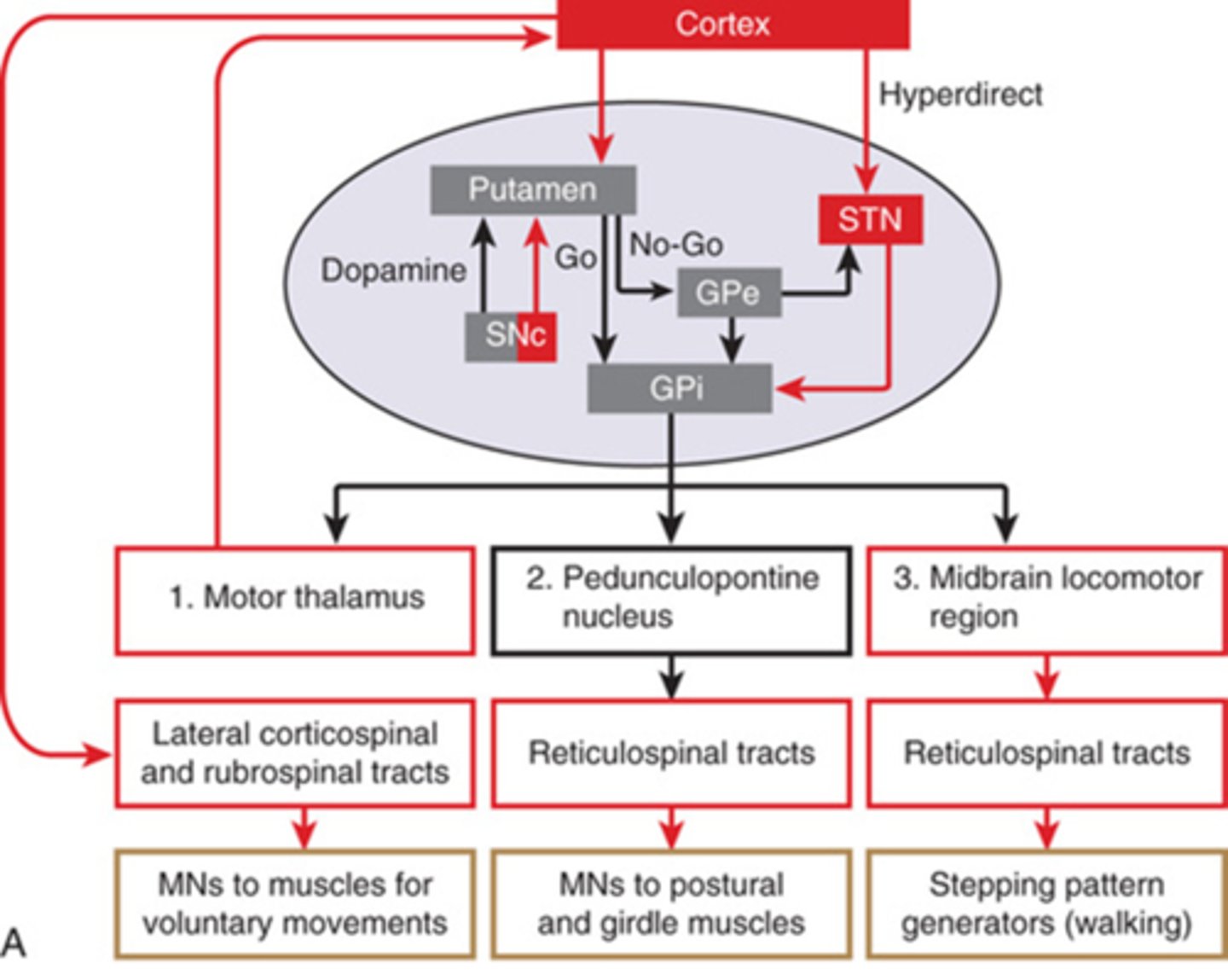
what is the importance of the globus pallidus tonically inhibiting the pedunculopontine N at rest
the pedunculopontine nucleus wont be able to inhibit the reticulospinal tract meaning that you will have excitation of your postural and girdle muscles at rest
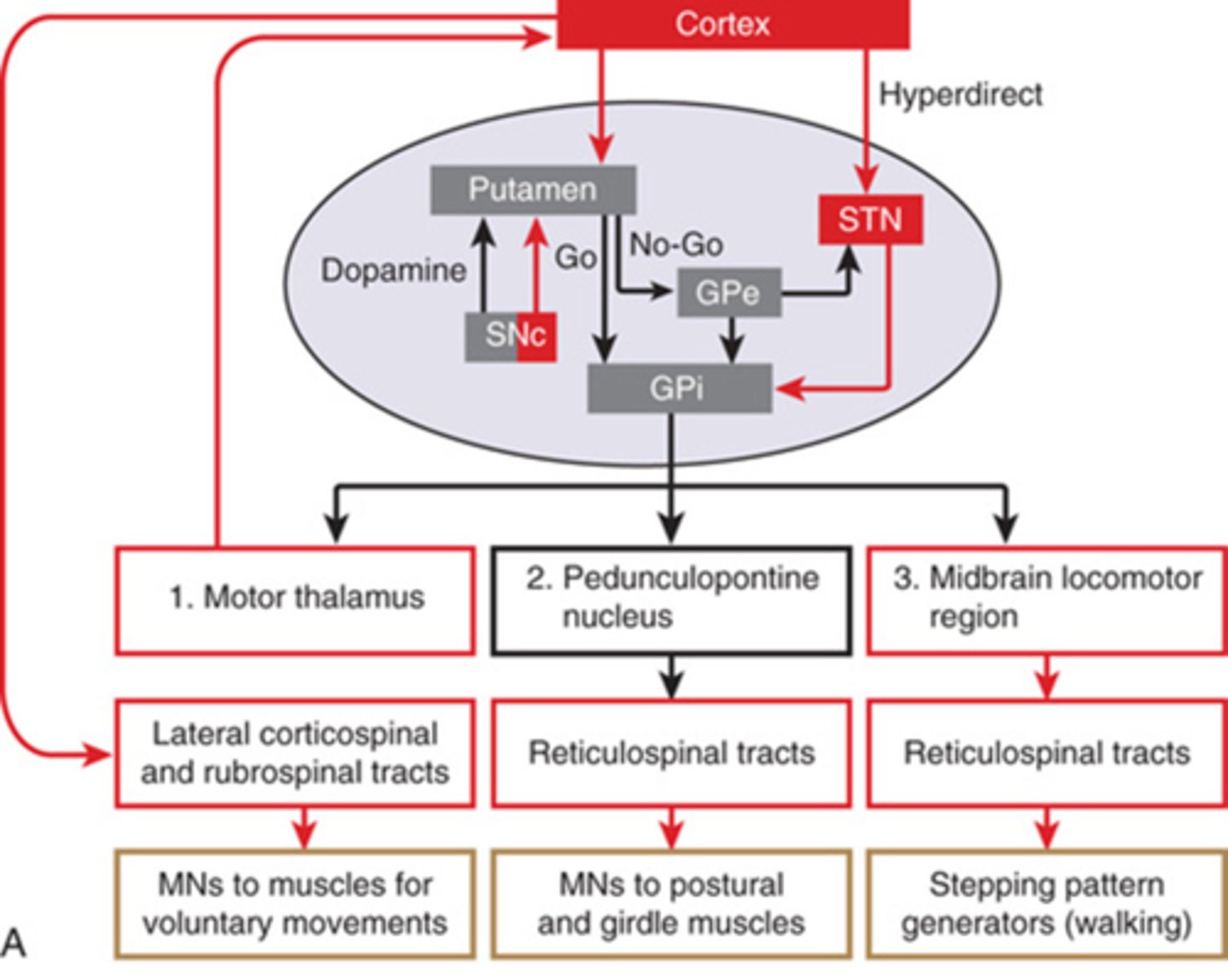
does the midbrain locomotor region excite or inhibit the reticulospinal tract
excite
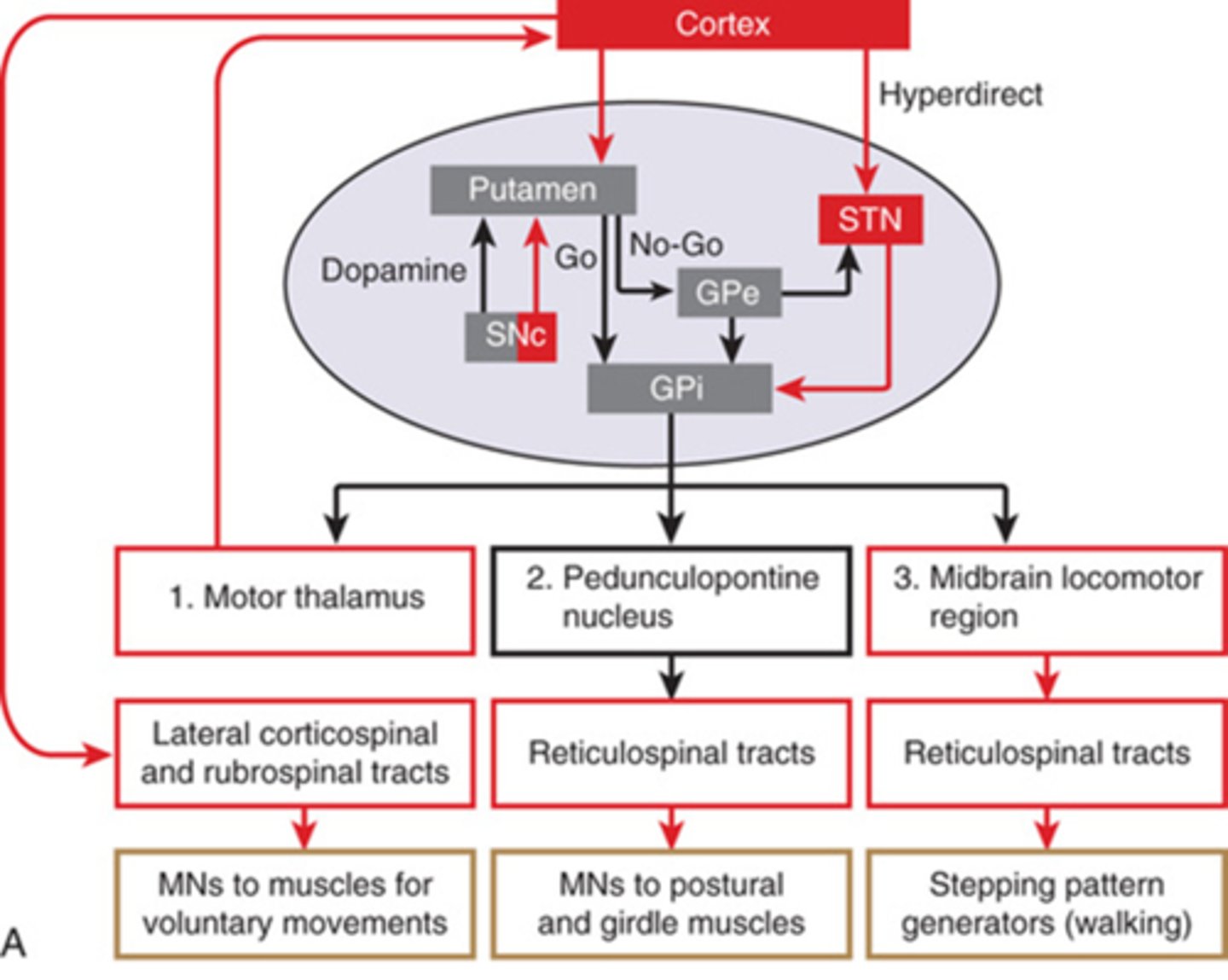
what occurs during rest and there is tonic inhibition to the midbrain locomotor region sent from the GPi
the GPi will inhibit the midbrain locomotor region, this will in turn cause there not to be excitation of the reticulospinal tract and inturn no gait will occur
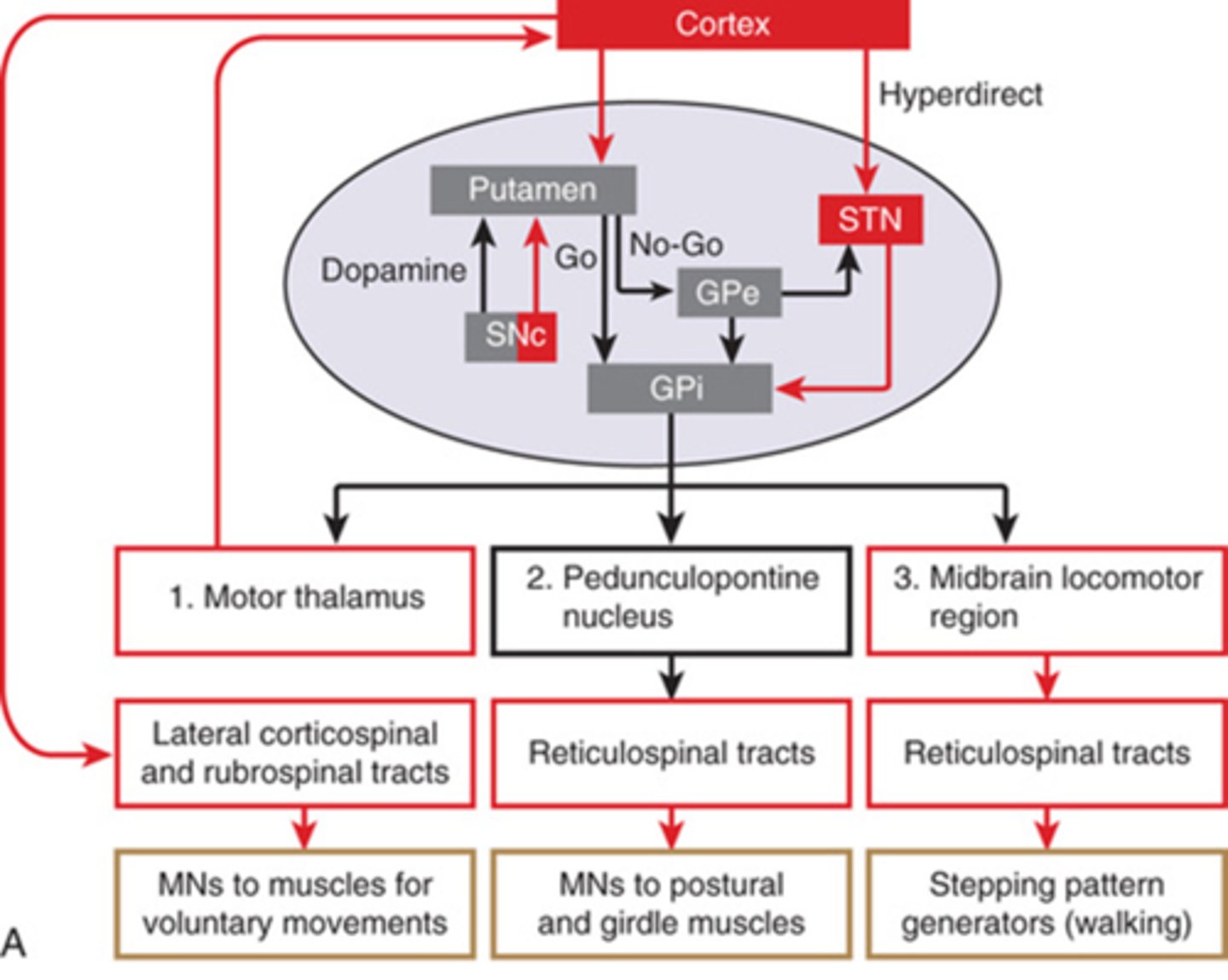
if the tonic inhibitory input to the midbrain locomotor region is stopped what will occur?
the midbrain locomotor region will excite the reticulospinal tract and that will cause gait to occur

what is the non-cortical structure that receives tonic inhibitory input that causes saccadic eye movements?
superior colliculi
does the direct or indirect pathway support movement?
direct pathway
does the direct or indirect pathway suppress movement?
indirect pathway
why is it important to integrate both the direct and indirect pathways
the direct pathway facilitates desired movements while the indirect pathway suppresses conflicting movements
what of input does the substantia nigra pars compacta give off to the basal ganglia
can be inhibitory or excitatory
what type neurons go from the substantia nigra pars compacta to the putamen
dopaminergic
what dopamine receptor is excitatory and facilitates the direct pathway
D1 receptors
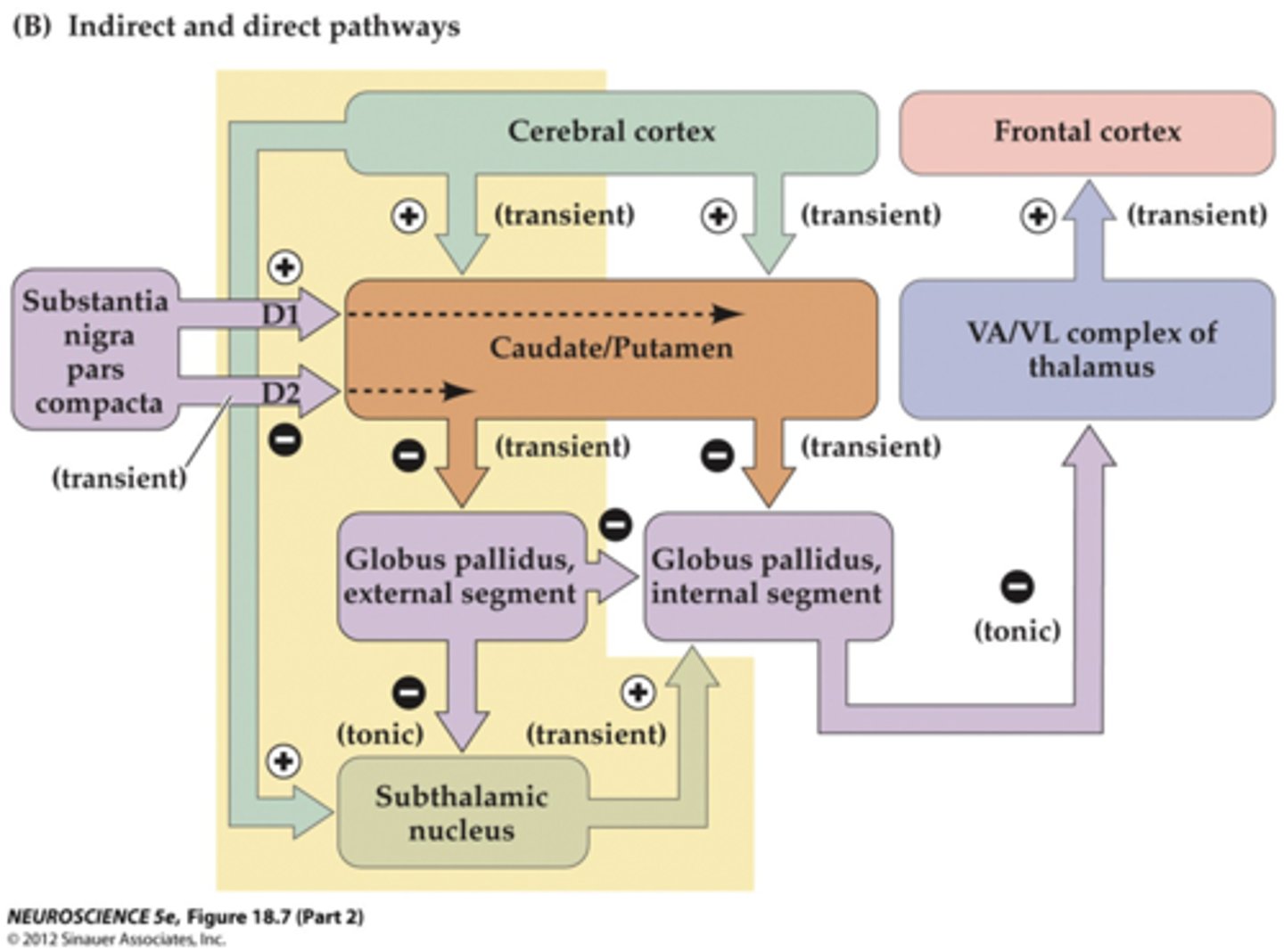
what dopamine receptor is inhibitory and delivers inhibitory input to the indirect circuits
D2 receptors
does dopaminergic input to the striatum increase or decrease excitability to the cortex?
increases
dopaminergic input to the striatum ___ the direct pathway and ____ indirect patheays
facilitates the direct pathway and inhibits the indirect pathway
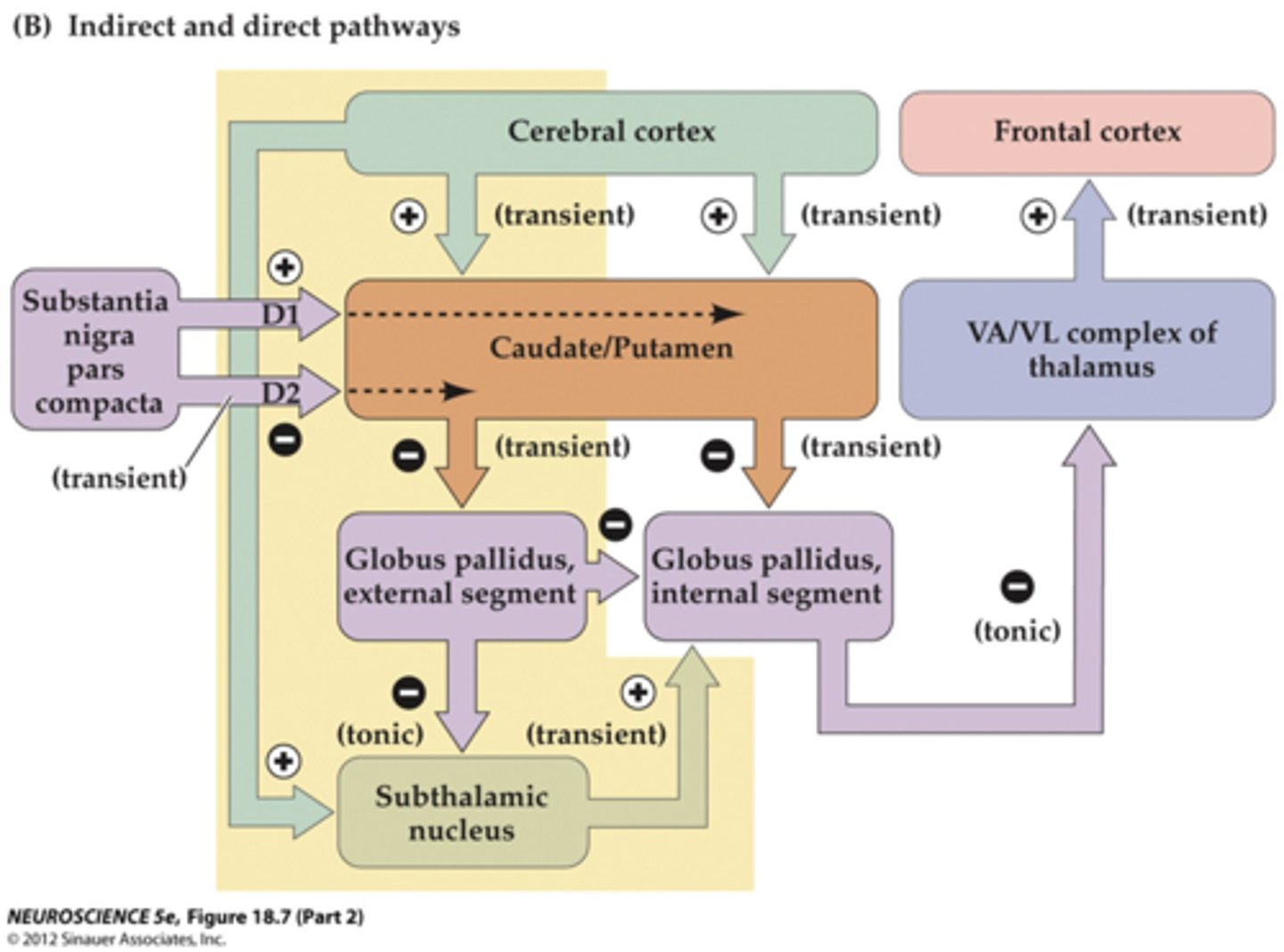
what are the 5 movement disorders of the basal ganglia
akinesia, bradykinesia, alterations in muscle tone, freezing and festinating gait, involuntary movement s
akinesia
failure to initiate movement or absence of movement
bradykinesia
slow movement
degeneration of what nuclei can cause parkinson's disease?
substantia nigra pars comptacta
what does degeneration of the substantia nigra do to the tonic inhibition sent to the motor thalamus, pedunculopontine nucleus, and midbrain locomotor region?
increases tonic inhibition to these non-cortical structures
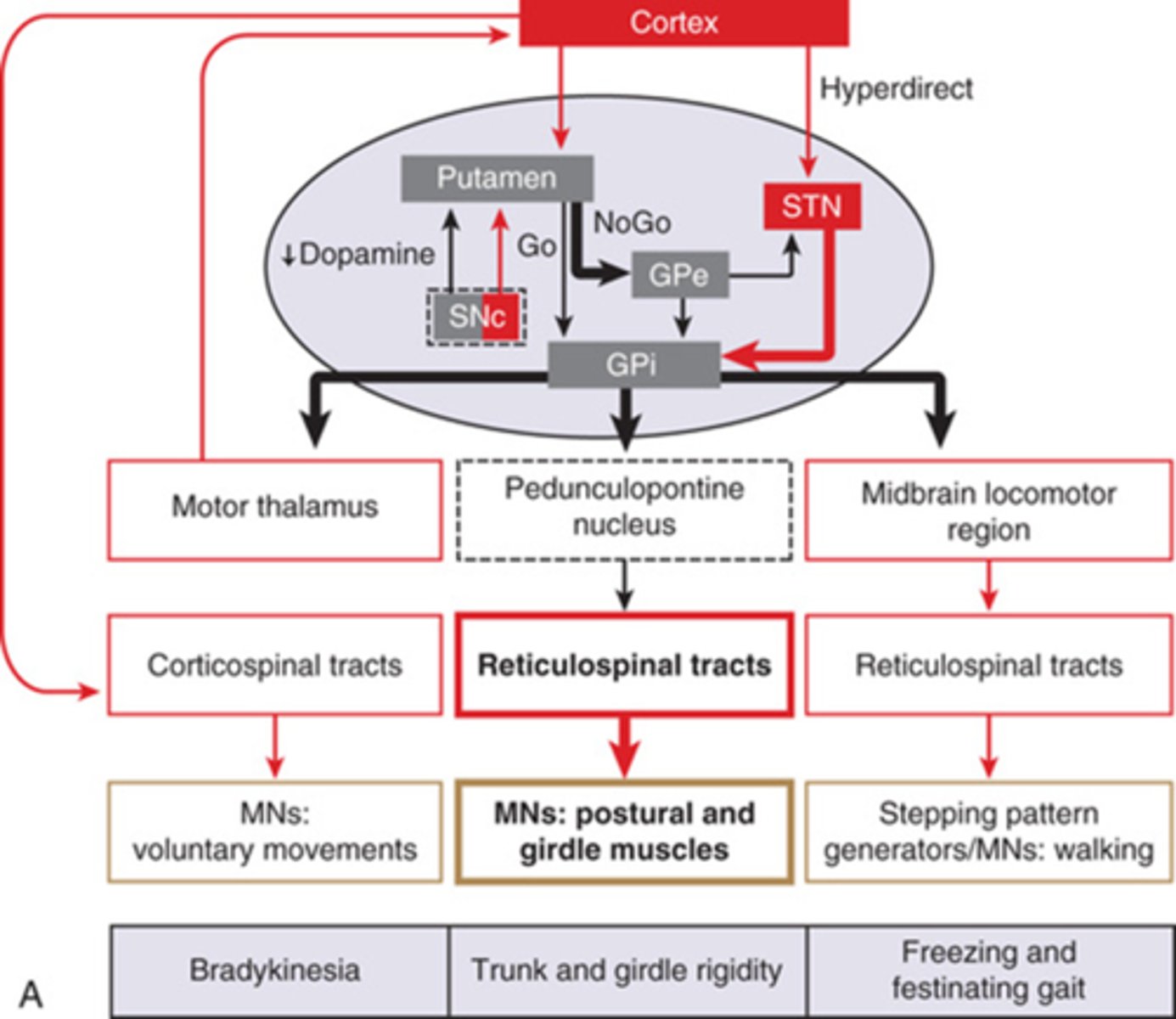
what would an increase of the tonic inhibition of the GBi on the motor thalamus cause?
this will effect the corticospinal tracts and cause bradykinesia
what would an increase of tonic inhibition of the GBi on the peduncopontine nucleus cause?
an increase in the inhibition of the inhibitory effect of the peduncle pontine nucleus , meaning an increase in reticulospinal tract function, causing trunk and girdle rigidity
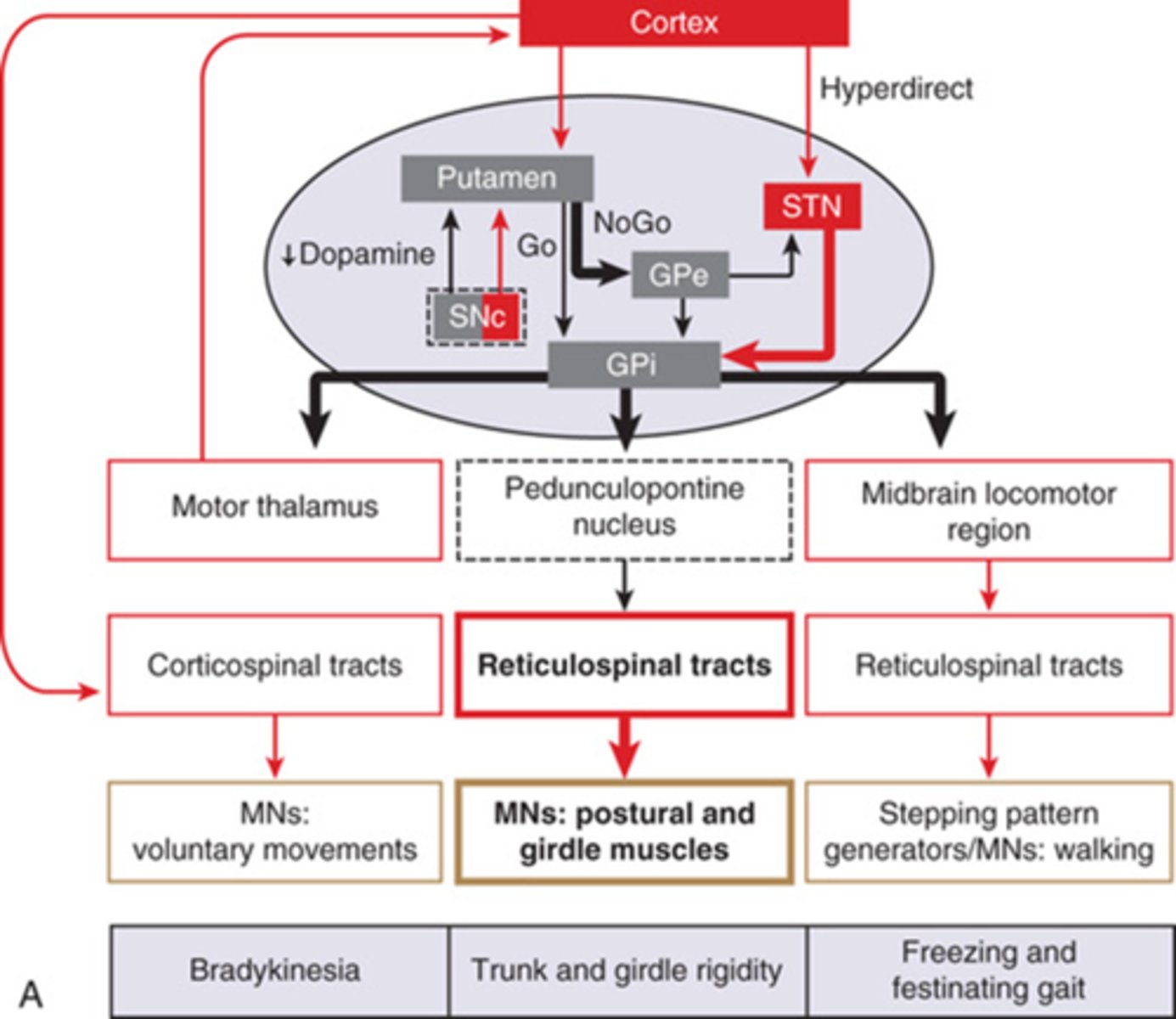
what would an increase of tonic inhibition of the GBi on the midbrain locomotor area nucleus cause?
inhibition of the midbrain locomotor region on the reticulospinal tract and cause freezing and festinating gait

the increase inhibition of the pedunculopontine nucleus causes an increase or decrease stimulus on the reticulospinal tract
increase
the increase inhibition of the midbrain locomotor region causes an increase or decrease stimulus on the reticulospinal tract
decrease
Parkinson's disease is a ____ of dopaminergic input, due to the degeneration of _____
decrease, substantia nigra compacta
which pathway is most likely involved in producing akinesia
indirect pathway
hypokinesia
reduced movement amplitude
both bradykinesia and hypokinesia are related to ____
increased tonic inhibition from BG to motor thalamus
rigidity is caused by:
increased tonic inhibition to the pedunculopontine nucleus
rigidity is often most pronounced where in the body?
proximal joints and trunk where there are large muscle masses
hypotonia of limb muscles are caused by:
increased tonic inhibition to motor thalamus
how would you describe freezing and festinating gait
difficulty in initiating walking and turning
what causes freezing/ festinating gait?
increased tonic inhibition to midbrain locomotor center
resting tremor
alternating to and from movement caused by alternating contractions in opposing muscles
rate of BG tremors
3-6 per second
what causes a resting tremor?
increases synchronization of oscillatory discharge
chorea
rapid, somewhat spasmodic involuntary movements- characteristic of huntington's disease
athetosis
slow, spreading contractions of closely related muscle groups